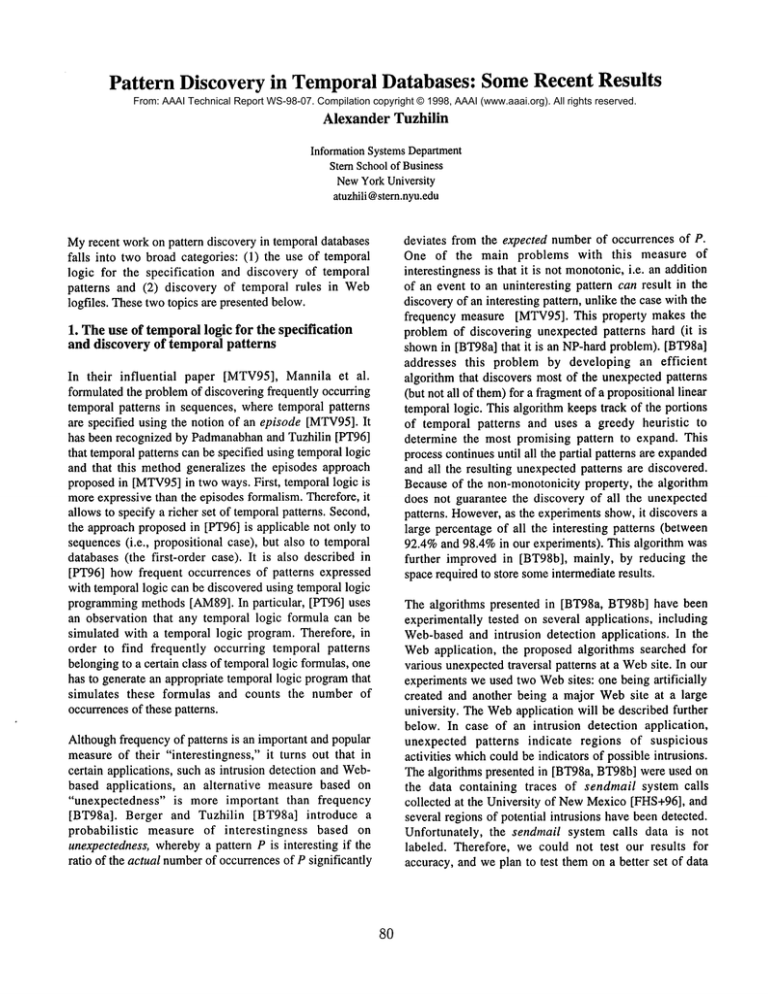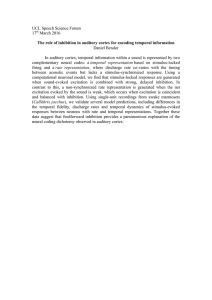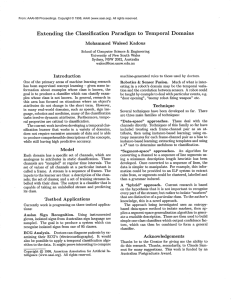
Pattern Discovery in TemporalDatabases: SomeRecent Results
From: AAAI Technical Report WS-98-07. Compilation copyright © 1998, AAAI (www.aaai.org). All rights reserved.
Alexander
Tuzhilin
InformationSystemsDepartment
StemSchoolof Business
NewYorkUniversity
atuzhili @stem.nyu.edu
deviates from the expected number of occurrences of P.
One of the main problems with this measure of
interestingness is that it is not monotonic,i.e. an addition
of an event to an uninteresting pattern can result in the
discoveryof an interesting pattern, unlike the case with the
frequency measure [MTV95]. This property makes the
problem of discovering unexpected patterns hard (it is
shownin [BT98a] that it is an NP-hardproblem). [BT98a]
addresses this problem by developing an efficient
algorithm that discovers most of the unexpected patterns
(but not all of them)for a fragmentof a propositional linear
temporal logic. This algorithm keeps track of the portions
of temporal patterns and uses a greedy heuristic to
determine the most promising pattern to expand. This
process continues until all the partial patterns are expanded
and all the resulting unexpected patterns are discovered.
Because of the non-monotonicity property, the algorithm
does not guarantee the discovery of all the unexpected
patterns. However,as the experiments show, it discovers a
large percentage of all the interesting patterns (between
92.4%and 98.4%in our experiments). This algorithm was
further improved in [BT98b], mainly, by reducing the
space required to store someintermediate results.
Myrecent work on pattern discovery in temporal databases
fails into two broad categories: (1) the use of temporal
logic for the specification and discovery of temporal
patterns and (2) discovery of temporal rules in Web
logfiles. Thesetwo topics are presented below.
1. The use of temporal logic for the specification
and discovery of temporal patterns
In their influential
paper [MTV95], Mannila et al.
formulated the problemof discovering frequently occurring
temporal patterns in sequences, where temporal patterns
are specified using the notion of an episode [MTV95].It
has been recognized by Padmanabhanand Tuzhilin [PT96]
that temporal patterns can be specified using temporal logic
and that this method generalizes the episodes approach
proposed in [MTV95]
in two ways. First, temporal logic is
moreexpressive than the episodes formalism. Therefore, it
allows to specify a richer set of temporal patterns. Second,
the approach proposed in [PT96] is applicable not only to
sequences (i.e., propositional case), but also to temporal
databases (the first-order case). It is also described
[PT96] how frequent occurrences of patterns expressed
with temporal logic can be discovered using temporal logic
programmingmethods [AM89]. In particular, [PT96] uses
an observation that any temporal logic formula can be
simulated with a temporal logic program. Therefore, in
order to find frequently occurring temporal patterns
belongingto a certain class of temporal logic formulas, one
has to generate an appropriate temporal logic programthat
simulates these formulas and counts the number of
occurrencesof these patterns.
Althoughfrequency of patterns is an important and popular
measure of their "interestingness," it turns out that in
certain applications, such as intrusion detection and Webbased applications,
an alternative measure based on
"unexpectedness" is more important than frequency
[BT98a]. Berger and Tuzhilin [BT98a] introduce a
probabilistic
measure of interestingness
based on
unexpectedness, wherebya pattern P is interesting if the
ratio of the actual numberof occurrencesof P significantly
8O
The algorithms presented in [BT98a, BT98b] have been
experimentally tested on several applications, including
Web-basedand intrusion detection applications. In the
Webapplication, the proposed algorithms searched for
various unexpectedtraversal patterns at a Website. In our
experiments we used two Websites: one being artificially
created and another being a major Website at a large
university. The Webapplication will be described further
below. In case of an intrusion detection application,
unexpected patterns indicate regions of suspicious
activities whichcould be indicators of possible intrusions.
The algorithms presented in [BT98a, BT98b]were used on
the data containing traces of sendmail system calls
collected at the University of NewMexico [FHS+96], and
several regions of potential intrusions have been detected.
Unfortunately, the sendmail system calls data is not
labeled. Therefore, we could not test our results for
accuracy, and we plan to test them on a better set of data
are targeted towards the discovery of association rules
[AIS93] and their extensions [PT98] and use the system of
user-specified (or learned) beliefs for discovering
unexpectedpatterns contradicting these beliefs. In the Web
application example, one maybelieve that "for all pages,
for all weeks, the number of hits to a page each weekis
approximately equal to the page’s average weekly hits."
This belief can lead to the discovery of the following
patterns using the discovery methods described in [PT97,
PT98]: (1) for a certain "Call for Papers" page, in the
weeks from September 10 through October 29, the weekly
access count is muchhigher than the average; (2) for
certain faculty position advertisement page, the weeks
closest to the deadline had unusually high visitation
activity. It is interesting to note that the approachdescribed
in [PT97, PT98]led to the discovery of several unexpected
Webvisitation rules.
that should be provided shortly to the intrusion detection
community.
2. Patterndiscoveryin Weblogfiles
Weblogfiles constitute a very interesting example of a
temporal database, and we worked on the problem of
pattern discovery in Weblogfiles. In particular,
we
considered two types of patterns for this Webapplication:
patterns as sequences (as explained in Section 1, e.g.
"before a user comes to page X, he or she visits page Y
immediately followed by page Z") and patterns as IFTHENrules (e.g., IF a user visits page X before page
THENthe user visits page Z). Wedescribe the discovery
of these two types of Webpatterns now.
As explained in Section 1, we studied in [BT98a] the
problem of discovering unexpected temporal patterns
expressed in temporal logic. As was explained before, a
pattern is unexpected if the actual number of its
occurrences significantly
deviates from the expected
number of these occurrences. The actual number of
occurrences can be computed directly from the Web
logfile. The expected numbercan be estimated by knowing
the link structure of the Web site and estimating
conditional probabilities of moving from one page to
another. As explained before, we applied the discovery
algorithm presented in [BT98a]to two Websites. The first
site is an artificially
created Website. The algorithm
managedto find 94.4%of all the unexpected patterns at
that site. The second site is a major Website at a large
university. It contained 4459 pages with 37954 links
between them. The algorithm was tested on two sequences
of page accesses for two individuals, each sequence having
more than 1400 events and extends over a period of 9
months. Our results were less encouraging: the algorithm
found only 2 patterns of length greater than 2 for both
sequences. These results are attributed to the following
factors [BT98a]. First, the total numberof pages was too
large in comparison to the number of events. Second, the
Website structure is constantly changing, whereas[BT98a]
considered the structure taken only at a specific point in
time. Therefore, calculations of the expected number of
patterns are only approximations of reality. Third, the
string of events was treated as one very long session,
whereas in reality there are manydifferent sessions, and
this causes technical problems described in [BT98a]. In
summary,[BT98a] identified these as serious issues that
need to be addressed in order to be able to discover more
meaningfulpatterns in Weblogfile data.
References
[AIS93] Agrawal, R., Imielinski, T. and Swami, A.
"Mining association rules between sets of items in large
databases." In Proc. of the ACMSIGMOD
Conference on
Managementof Data, pp. 207-216, 1993.
[AM89] Abadi, M. and Manna, Z. "Temporal logic
programming." Journal of Symbolic Computation, 8:277295, 1989.
[BT98a] Berger, G. and Tuzhilin, A. "Discovering
unexpectedpatterns in temporal data using temporal logic."
In Temporal Databases - Research and Practice. 0.
Etzion, S. Jajodia, S. Sripada (eds). Springer-Verlag,1998.
[BT98b] Berger, G. and Tuzhilin, A. "A temporal logic
approach to discovering unexpectedpatterns in sequences."
WorkingPaper IS-98-007, Stern School of Business, NYU,
1998.
[FHS+96] Forrest, S., Hofmeyer, A,, Somayaji, A. and
Longstaff, T. "A sense of self for Unixprocesses." In Proc.
of the 1996 IEEESyrup. on Security and Privacy, 1996.
[MTV95]Mannila, H., Toivonen, H. and Verkamo, A.I.
"Discovering frequent episodes in sequences." In Proc. of
the 1st International Conference on KnowledgeDiscovery
and Data Mining, 1995.
[PT96]Padmanabhan, B. and Tuzhilin, A. "Pattern
Discovery in Temporal Databases: A Temporal Logic
Approach." Proc. of the 2nd International Conference on
KnowledgeDiscovery and Data Mining, 1996.
In contrast to [BT98a], Padmanabhanand Tuzhilin [PT98]
addressed the problem of discovering unexpected rules in
Weblogdata. The methods described in [PT97] and [PT98]
81
[PT97] Padmanabhan, B. and Tuzhilin, A. "Discovering
Unexpected Rules in Data Mining Applications." Proc. of
the Wrkshp on Information Technology and Systems, 1997.
[PT98]Padmanabhan, B. and Tuzhilin, A. "A BeliefDriven Method for Discovering Unexpected Patterns."
Submittedfor publication.
82








